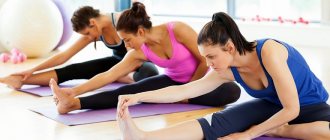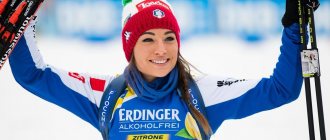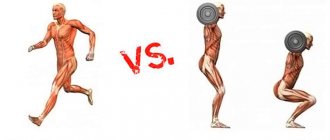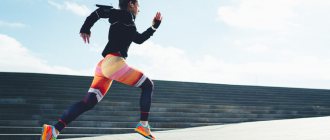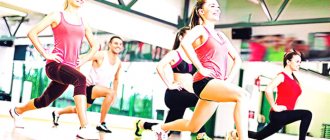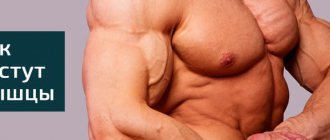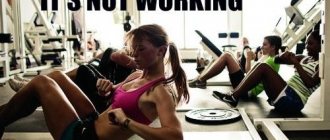One of the key conditions for achieving results in fitness and other sports is recovery. It involves returning your physical condition to normal and adapting to upcoming stress to improve your fitness. Lack of balance between intense training and rest negatively affects athletic performance. Over the long term, this can lead to a plateau or reverse effect, poor health, muscle pain, and decreased productivity. To avoid loss of strength and not worsen athletic performance, you need to recover effectively after exercise. We will tell you in this article how to do this quickly and correctly to increase the functionality of the body.
Main phases of recovery
At light loads, all internal processes operate as usual. Increasing activity and performing heavy exercises mobilize the body's internal reserves, forcing it to work with greater productivity. The body responds to intense stress with the appearance of pain. This occurs due to the production of cortisol, which breaks down muscles. Recovery in this situation is important because it helps return the physiological and biochemical state. The essence of balanced rest is to reduce the negative consequences due to microtrauma of muscle fibers and to benefit from exercise on the machine. Research explains that neglecting this stage leads to deterioration in athletic performance. A person is not able to maintain the chosen pace if he does not follow the regime. In addition, achieving results and setting personal records requires complete recovery after each visit to the gym. After exercise, the body prepares for future stress by increasing muscle mass. The higher the intensity, the more serious the preparation. Therefore, training at full capacity using all resources is considered the most effective. However, endurance and strength in this case will improve not during training, but after it.
Despite the individuality and dependence of rest on various factors, recovery of the body is divided into four phases:
- Fast. About 30 minutes after completing your workout. A person feels intense hunger as the body tries to quickly return to its natural state by replenishing its nutrient reserves.
- Slow motion. Regeneration of tissues and cells. The athlete’s body begins to return to normal - the water-electrolyte balance is restored, enzyme, protein and amino acid synthesis starts, and nutrients supplied with food are absorbed.
- Supercompensation. Activates a few days after training and is effective for 48 hours. During this period, an increase in physical indicators is observed. Since a person with supercompensation is ready for new loads, it is recommended to perform a new workout before the end of the phase.
- Deferred. Occurs if an athlete stops exercising for a long time. During this phase, muscle tissue returns to the same shape it had before going to the gym.
Depending on the muscle group, recovery takes 36-72 hours. This should be taken into account when drawing up a program, since intense exercise more than once every 2-3 days does more harm than good. It is worth considering that larger muscles require more rest time. After cardio exercises, which do not require expenditure of energy reserves and do not damage a large number of muscles, full recovery takes up to 3 days.
Muscle pain after training: how to get rid of it?
Pain is formed at the tissue and nerve levels when the pain sensitivity system is brought out of balance. When interacting, tissue and nervous factors form a pathological system, which can only be broken with the help of specially selected therapeutic measures. 60
Prolonged persistence of pain contributes to increased muscle tone, which can lead to ischemia and fibrous tissue degeneration. Incorrect or insufficient therapy can lead to chronicity and generalization of muscle fatigue. Treatment of DOMS should be comprehensive, etiological and pathogenetic. Otherwise, the therapy will only bring a temporary effect. 60
To ensure the prevention and correction of muscle microdamage syndromes, it is recommended to use non-steroidal anti-inflammatory drugs. These can be ointments, creams, gels for muscle pain after exercise. They help reduce the manifestations of the inflammatory process and have an analgesic effect. 59
30g
recommendations for use
Apply a small amount of gel (3-5 cm) 2-3 times a day, followed by rubbing into inflamed or painful areas of the body. The duration of use of the drug should not exceed 14 days without consulting a doctor.
instructions
50g
recommendations for use
Apply a small amount of gel (3-5 cm) 2-3 times a day, followed by rubbing into inflamed or painful areas of the body. The duration of use of the drug should not exceed 14 days without consulting a doctor.
instructions
100g
recommendations for use
Apply a small amount of gel (3-5 cm) 2-3 times a day, followed by rubbing into inflamed or painful areas of the body. The duration of use of the drug should not exceed 14 days without consulting a doctor.
instructions
Basic recovery methods
During the period when the athlete is resting from exercise, training must be stopped. An important means for muscle growth and maintaining the body in good shape is sleep. It is at this time that muscle tissue actively grows and increases in volume. You need to allocate at least 8 hours for sleep. A few more conditions must be observed - for good rest, it is better to fall asleep in complete darkness and silence, on a comfortable pillow and a comfortable mattress.
The following means affect the improvement of sports performance and recreation efficiency:
- Gradual slowdown. It is not advisable to complete a session in the gym with strength exercises. In this case, stretching or a cardio stationary bike or treadmill at an easy pace will help.
- Drink plenty of fluids. Water remains the best way to support the body, as it affects a large number of processes. Water prevents overtraining and promotes effective rest. However, you should not drink in large quantities. Instead of drinking a bottle at once, it is better to take several sips. Large amounts of water strain the heart.
- Compliance with diet. It is recommended to eat nutritious food, since it is during the first 30 minutes that the body absorbs carbohydrates and amino acids. Depending on the intensity, duration of exercise and physical fitness, each athlete selects the right amount of food.
- Use of special additives. Modern pharmacology offers medications for quick recovery. These can be plastic tablets that accelerate protein synthesis, adaptogens and energy drinks that accelerate the absorption of nutrients. Despite the benefits of the drugs, they should be used only after consultation with your doctor.
- Temperature effect. High temperature improves blood circulation and increases the speed of metabolic processes - cells regenerate faster, muscle tissue is better restored. A positive effect, in addition to a warm sauna, is observed when the temperature decreases. Swimming in an ice bath and rubbing with ice improves the condition because it relieves muscle swelling.
- Massage. The procedure, which is recommended to be performed in the first 30 minutes after training, relieves pain in muscle tissue. It is suitable for every athlete and can be combined with other recreational aids. Massage reduces muscle swelling, reduces fatigue, improves blood circulation and relieves muscle spasms.
- Recovery workout. Aerobic exercise and gentle cardio are suitable. A light jog or bike ride for 10-15 minutes at a calm pace will speed up blood circulation and disperse lactic acid.
After physical exercise, foods with carbohydrates and proteins are recommended. To grow muscle mass, it is enough to consume 50-90 grams of complex carbohydrates and 20-30 grams of animal protein. Additionally, you can use protein shakes.
Cardio exercises after the main lesson should be given more attention, because they strengthen the heart. The duration of cardio training depends on how you feel. If after physical exercise your heart rate exceeds your norm by more than 20-30 beats, light cardio is necessary. It will remove metabolic waste products from the body. It is recommended to do 2 minutes of low-intensity exercise for every 10 beats above normal heart rate. If the heart rate is about 140 beats, and the norm does not exceed 60, then the required duration of cardio is 16 minutes. Organizing a high-quality restoration process requires knowledge and experience. To choose the right distribution of forces, we recommend turning to professional trainers. Qualified fitness instructors will offer you an individual program. You can buy a gym membership online or in our club. By phone you can get additional advice about discounts, promotions and benefits of the club card.
Mechanical hypothesis
The mechanical hypothesis states that the main cause of muscle damage and, accordingly, the appearance of soreness is eccentric muscle movements.
What is eccentric muscle movement? There are three types of muscle work: concentric , isometric and eccentric . And notice that we use the word "job" and not "cut."
Concentric muscle work
During the concentric movement, the muscle shortens, and only then does it actually contract. The muscle shortens when lifting something, or during movement of the part of the body for which it is responsible.
- Example: the ascending phase of a squat or bench press.
Isometric muscle work
During isometric work, the muscle does not change in length.
- Example: plank or trying to hold the weight at the peak point (muscles tense, but no movement occurs).
How quickly does stamina decrease?
Endurance is lost much faster than strength. This is due to the fact that in the absence of physical activity for a month or more, plasma volume decreases. As a result, the blood becomes more viscous, which impairs the supply of oxygen to the tissues.
In the absence of training, the MOC indicator, the maximum amount of oxygen that the body can consume, also drops sharply. It decreases especially strongly in the first time after stopping classes. In 10 days it will decrease by 7%, after which this process will slow down, so by the third month the drop will be only 15%.
The coach answers: how to improve endurance?
However, if you don't do cardio exercises, your endurance can decrease by 25% in a few weeks. This is most noticeable among beginners.
Overrated Superfoods
Goji berries
Superfoods are a much-debated phenomenon lately. This is the name given to a number of products that supposedly have very high nutritional properties, which is why they are especially loved by athletes and people on a diet. However, very often the claimed properties are a marketing hoax. Let's consider this phenomenon using the example of goji berries. It was widely claimed that this product had the highest levels of vitamin C in the world. But in fact, it turned out that there is no more of it in them than in other fruits and berries, for example, citrus fruits. It has also been reported that consumption of goji berries prevents breast cancer in 75% of cases. American nutritionist Earl Mindell spoke about this with reference to clinical trials at the Memorial Sloan-Kettering Cancer Center. However, this center did not actually conduct such tests. In addition, there is no proven way to prevent cancer, you can only reduce its risk. Thus, superfoods are unlikely to have any special place in sports nutrition, although they most likely will not harm you.
Precautionary measures
Considering the specifics of its implementation, the Kegel complex for women has almost no contraindications. Exception:
- Recent miscarriage;
- Premature birth and major surgery;
- The presence of malignant neoplasms;
- Prolapse of the uterus.
In these cases, you should not overexert yourself. But in any case, you should always consult your doctor before starting classes. Even if there are no contraindications, but you feel discomfort or pain during exercise, you should stop and consult a doctor. You can resume training only with the permission of a doctor. A consultation with a gynecologist will be needed if after 3-5 months of regular training there is no change for the better. The rest of the exercises are flawless - there are no strength loads or cardio stress, no need to spend money on exercise machines, equipment, or a trip to the gym. The minimum investment of effort and time will pay off with improved well-being in all areas.
Testing an Alternative Explanation for the Interference Effect
If the above hypothesis is correct, then the proximity and relative order of aerobic and strength training will influence the interference effect.
Aerobic training performed after strength training should reduce muscle adaptation if the resulting central nervous system fatigue persists until the next strength training session. If aerobic training is carried out immediately before strength training, the interference effect will be stronger; if you perform aerobic exercises immediately after strength training or the next day, you will be weaker.
Indeed, when strength training is performed before aerobic training, the interference effect is small, even in well-trained athletes. According to the literature, the interference effect is greater when aerobic exercise is performed immediately before strength training, compared to aerobic exercise performed immediately after strength training.
If the hypothesis is correct, we would expect the interference effect to have a greater impact on measures such as maximal strength and power than on muscle size. Indeed, literature data confirm this. This is because the ability to recruit motor units is an adaptation to long-term strength training, and this adaptation allows for increases in maximum strength and power. Failure to recruit all motor units during exercise means those muscle fibers are not trained and strength does not increase.
Bystrumgel for muscle pain
For local treatment of affected muscles, joints, and ligaments, a modern drug based on ketoprofen, Bystrumgel, can be used. It has analgesic, antiexudative, anti-inflammatory effects. eleven
Bystrumgel contains essential oils of lavender and orange flowers, so the drug has a pleasant aroma. The anesthetic gel can be used for the symptomatic treatment of bruises, sprains, joint syndrome, and muscle pain. Ketoprofen, which is part of Bystrumgel, does not have a catabolic effect on cartilage tissue. eleven

